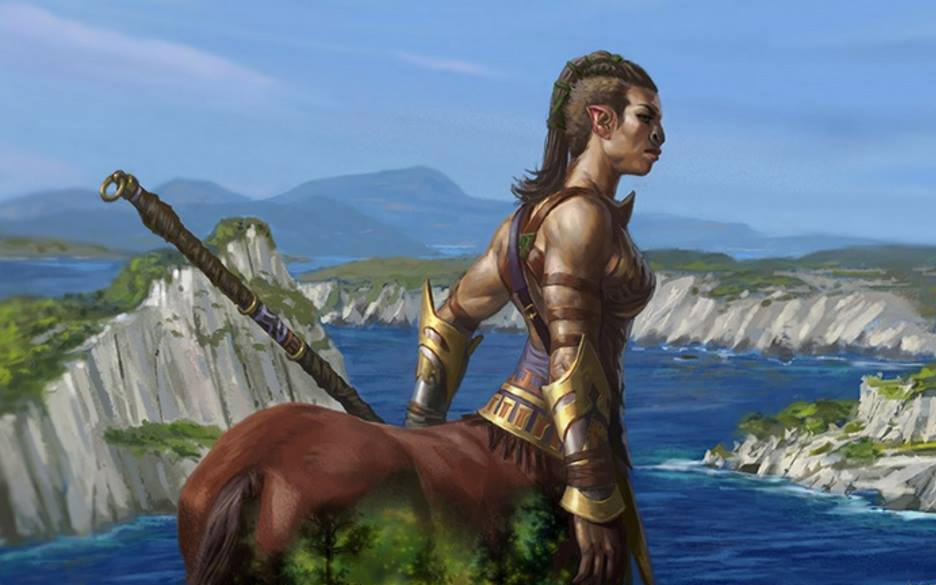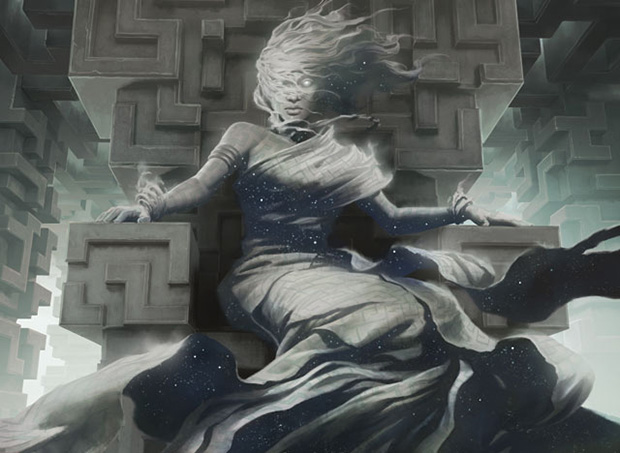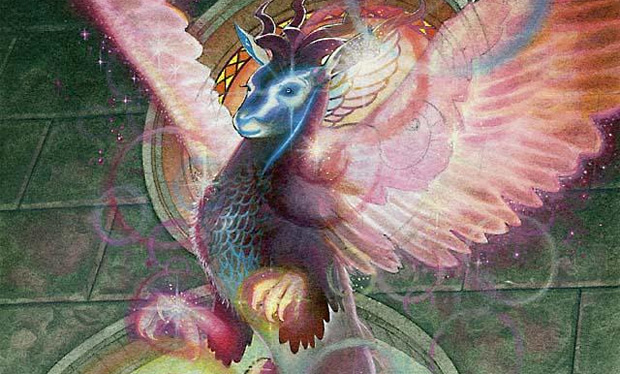By: Travis Allen
This is going to be one of those rare weeks where I teach you guys something actually useful that you can apply yourself to situations down the road. The Block Pro Tour in Hotlanta just happened and we’re going to separate the signal from the noise. These PTs are important because they are a possible sign of things to come. The future can be changed, but it isn’t always. Even when things don’t shake out quite like this, the role players are still typically big parts of the story, just in a different costume.
Let’s start with what’s worth noticing. In the first instance of someone winning their first Pro Tour after being inducted into the Hall of Fame (I’m too lazy to find out if this is true), Chapin took home a well-deserved trophy. He played Spirit Jund, aka “a three color pile of the best cards in the format.” It just happened to show up in BGW this time around.
Manabases at a PT are a little tough to evaluate because they’re so constrained by lack of options. I’m sure if Pat had access to shocks his mana would look a little different. Even still, that’s a full-on set of Temples and Mana Confluence. The Temples are well-worn at this point and should surprise nobody. They’re all good, trade for as many as you can, etc etc. Four Mana Confluence is the bigger deal. Mana Confluence is unquestionably powerful, but it comes at a great price. When Overgrown Tomb comes into play you pay your two up front and you’re done. Drop your envelope full of money on the gift table as you come in and hit the open bar as many times as you want. Mana Confluence is a cash bar though, and it’s not cheap. After two drinks you’ve paid the same as the guy playing Overgrown Tomb, which means if you play it on turn one you’ve lost more life by the time you tap it on turn three. There’s a good chance you’re going to have to tap it a few more times as well. That Pat would play four of them means he’s really, really in the market for hitting his drops on schedule and doesn’t mind paying a butt-ton (that’s a real unit of measurement look it up) to do it. The format has been a little cool on Confluence relative to expectations, but it looks like we may be in for more of it in the future.
There hasn’t been a more “well dang better grab a set of that” card at a Pro Tour than Courser of Kruphix in possibly ever. There were twenty-eight – TWO EIGHT – copies in the Top 8, of a maximum thirty-two. Seven out of eight lists ran the full set in the main deck. It probably won’t be this heavily represented once we get M15 and #MTGKTK, but dang that is a lot of centaurs. It’s easy to say the metagame was weird and CFB represented a big part of the Top 8 and blah blah blah. Courser has been holding his own in Standard already so we know this isn’t just a flash in the pan.
Boros Reckoner was a solid $20 at his height and Courser looks like he could pull the same thing. That price was mostly a spike, but Reckoner easily hung between $10 and $15 for months at a time and climbed into the $18 range more than once. Courser will have increased by several dollars at least by the time we hit November barring some catastrophic metagame.
There’s a similar saturation of Sylvan Caryatid and Hero’s Downfall, but those are Theros rares and are therefore far less likely to be financially noteworthy. Remember the 6:2:1. Courser is that 2, but Caryatid and Downfall are the 6. Much tougher to see huge spikes. They are still going to be a big part of the Standard landscape in the fall, but there will be better places for trade equity.
Elspeth was expectedly a big part of the Top 8 as well, although not quite like manhorse. Even though she’s from Theros, just as Caryatid and Downfall are, I like her much more than those two. Why is that? For one, she’s a mythic. Even though she’s a 6 in 6:2:1, there are still roughly 1/8th as many copies as any given Theros rare, meaning the total number of absolute copies is on the much lower end of the scale. She’s also a planeswalker, which comes with an automatic demand multiplier. While Caryatid and Downfall are (conceivably) replaceable by something else, it’s very unlikely something will come along and be better at what Elspeth does than Elspeth. She sees roughly the same amount of play as Domri Rade does/did, and Domri went from $10-$15 to $20-$25 at rotation. Elsepth is still just about $20 and isn’t dropping much/at all this summer, so she should be a solid $30+ come September or October. In fact, I wouldn’t be surprised to see her crest $40 if the format shakes out in her favor. (Did you know she died at the end of Theros? I found out yesterday. Good riddance.)
Kiora popped her head in a few times which tells me she’s still going to be a reasonable option in the fall. She’s a lot less reliable than Elspeth is in terms of playability, but she’s certainly capable. I’m not as hot on her jumping as significantly as I am Elspeth, but she’ll definitely see a rise. If she’s around $15-$16 right now, then I fully expect $20+ with the best case scenario being $30 or so. Go ahead and trade for copies now, and if they get down closer to $12 trade for every single one you see.
Bringing up the rear are Ashiok and Xenagos. They saw the least play but I like them the most out of the four. They’re dirt cheap right now, scraping the price floor of playable Planeswalkers. If you trade for these guys one of two things will happen in the fall: They’ll see no play and rise a little bit, or they’ll end up being awesome and rise a ton. Plan accordingly.
Thoughtseize is still good. It only stands to gain. Yawn.
Now we get to the part where I get to actually teach you something worthwhile. Block Pro Tours are a great look ahead, but there are always a few cards that look like they’re going to be a big deal in the fall and then fail to pan out. Anyone remember the four Devastation Tide and Tamiyo in Hayne’s Block-winning list from PT Avacyn? Finkel’s Dungeon Geists? Wescoe’s winning four Advent of the Wurms a year later? No? Not surprising. They were all nearly entirely absent from the following Standard. I got burned by the Advents but managed to dodge the rest. How?
The biggest factor in determining whether a break-out Block performance is sustainable is how well the card will fare when you add 500 more to the format. Let’s apply this concept to a card that was a big part of of the Top 8 that I didn’t talk about yet. How about, oh, Prognostic Sphinx. There were plenty of people out there on r/mtgfinance and elsewhere that were discussing it as a spec option. It was closing games on coverage and looking good doing it.
Prognostic Sphinx is a terrible spec.
Let’s start by looking at what other options the CFB team had for filling out that slot. They needed something that could close games, preferably with evasion, and it needed to do well in a grindy, slow Block format. Blue would be preferable, because they want access to Ashiok and Kiora.
What were their options besides Prognostic? Well, there’s Arbiter of the Ideal, a card that may do something for you the third turn it’s in play. You’ve also got Celestial Archon, which is expensive to bestow and doesn’t fit as well with the controllish GB shell they’ve got going. There’s also…Chromanticore? Medomai? Maybe one of the seven-drop black demons?
Prognostic Sphinx isn’t a bad card at all. In a Standard format with miracles it would be amazing. But in Theros Block, it’s just the best of a bad situation. What do you think the odds are that both M15 and Khans won’t bring a more powerful closer? They aren’t looking for the core of a deck here; they really just need a creature that get the job done. If Aetherling were legal, it absolutely would have been that. Hell, I’m fairly confident that Morphling would have been played instead of Prognostic if they had the option.
It also didn’t really have to be blue either. They were glad it was because it meant they got Kiora and Ashiok, but those may not be the right option in the future either. The core of the deck is clearly GB, and the third color could feasibly be anything, as evidenced by Chapin taking down the whole thing with GBW.
Furthermore, as card pools grow larger the decks tend to get cheaper and more aggressive. You can’t build a competitive aggressive sixty card deck with only twelve playable cards at two mana or less, but when the card pool doubles and you’ve got access to twice as many your deck gets lower to the ground and meaner. More cards smooths out mana curves as well. As a rule of thumb, the more cards you put in the pool the cheaper and faster the decks get. Need proof? Look at the speeds of Vintage, Legacy and Modern. What does this matter here? Prognostic Sphinx is slow. It’s on the pricier side of the mana curve. The conditional hexproof requires you to discard, meaning it’s probably going to take more time to kill your opponent. Scrying every turn sets up future turns, but it doesn’t actually put cards in your hand. It’s a slow, grindy creature at its best in a slow, grindy format.
All of this means that buying Prognostic Sphinx is just a complete waste of money. Remember that it’s a rare from Theros. Even if you got them at $.50, what’s your goal? What has to happen for you to make a reasonable amount of money? How many do you need to buy? Take a look at my article about my experience with Ghaves a few weeks ago. Even if you get in on Prognostic at $.50 each and it quadruples to $2, you’re probably barely making $10 an hour, if you even manage that.
Courser of Kruphix, Sylvan Caryatid, and Thoughtseize are powerful, inexpensive cards that can fit nearly anywhere. Planeswalkers are very powerful permanents that warp board states. Cards like Prognostic Sphinx are high on the curve and easily outclassed by other options. You can learn to identify the flashes in the pan by asking yourself directed questions about the metagame, the quantity on the market, and how easily it can be replaced in a larger format. Was there a weird Block meta that resulted in an odd card being well positioned? How many copies of the card in question are in the format? Was it printed in the large fall set, or the under-drafted third set? Could you imagine easily replacing the card with a card that’s legal in Standard right now? Is there casual demand? Are people likely to play it as a complete set?
Hopefully this walkthrough will give you the tools needed to make informed decisions when evaluating cards that show up at Block pro tours, and perhaps even speculating in general. It can certainly be tricky – the stack of Advent of the Wurm on my desk will testify – but at the very least, you should hopefully be able to dodge the obvious pitfalls.
And if you’ve got thirty or forty Prognostic Sphinx in your TCGPlayer order history, well, my condolences.







